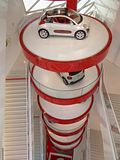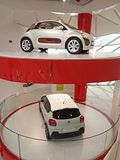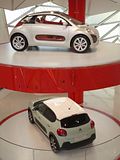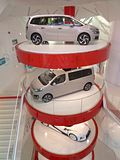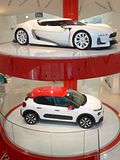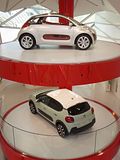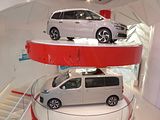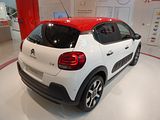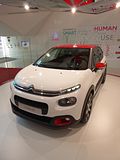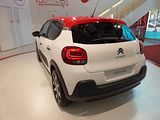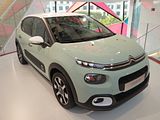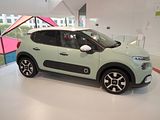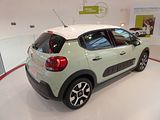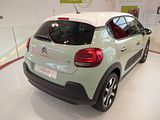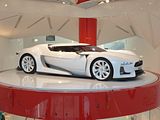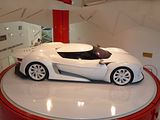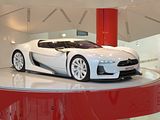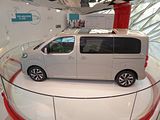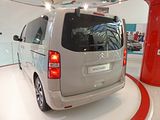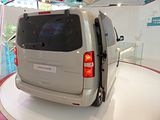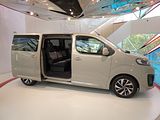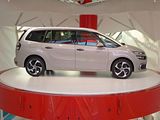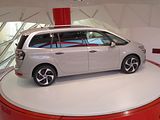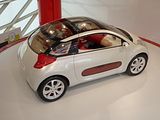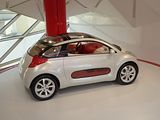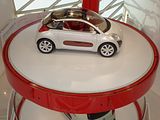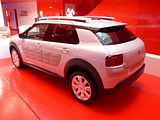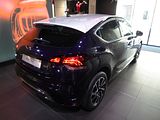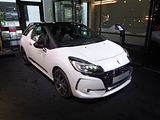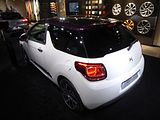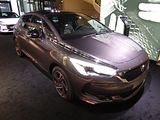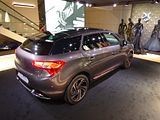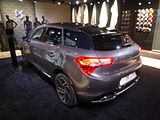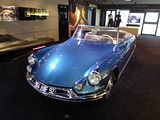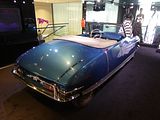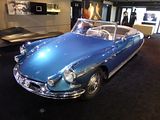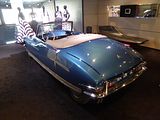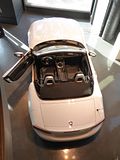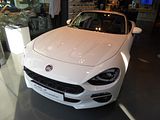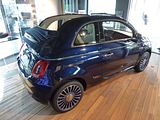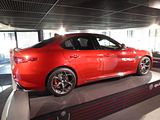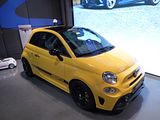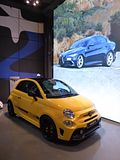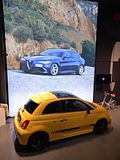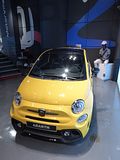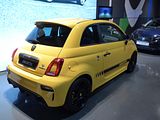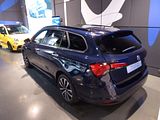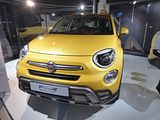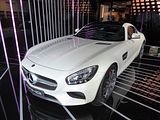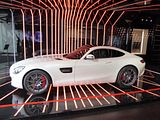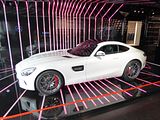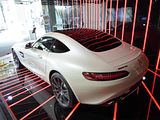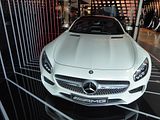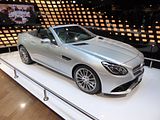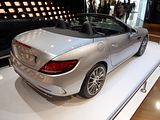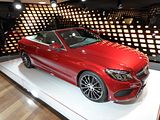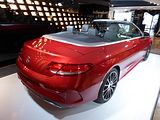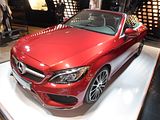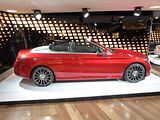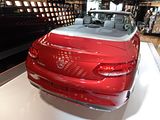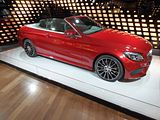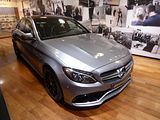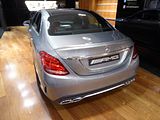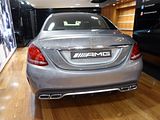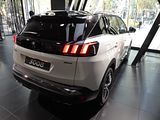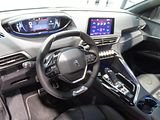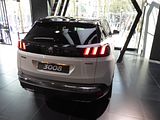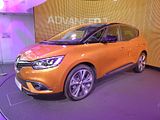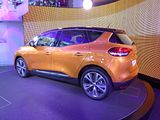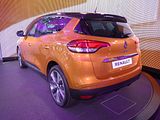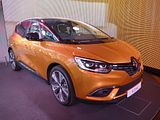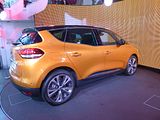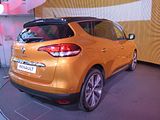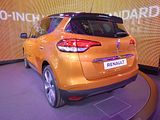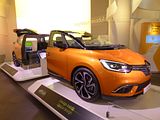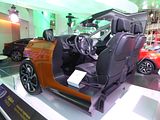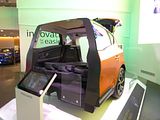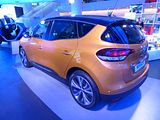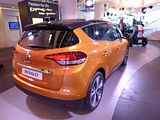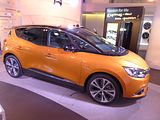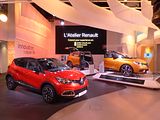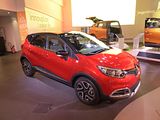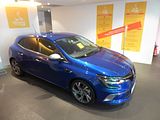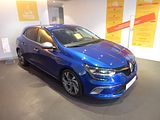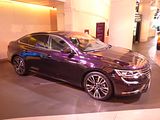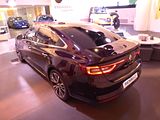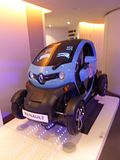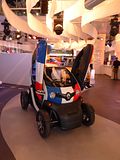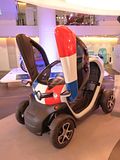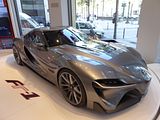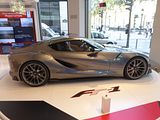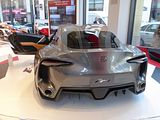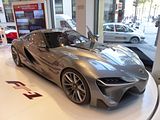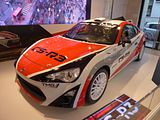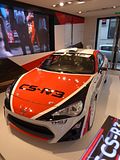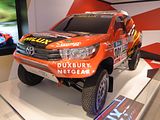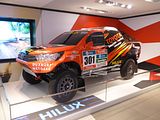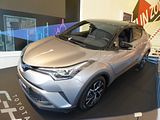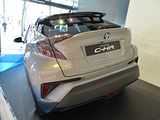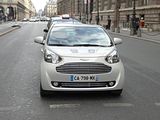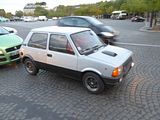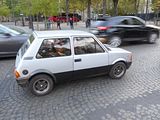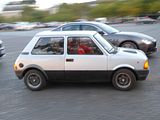Having decided to attend the Mondial de ‘Automobile, otherwise known as the Paris Show, on a Friday, in an effort to try to reduce the challenge of the crowds, that left the whole weekend to do other things in Paris and environs. With a forecast for some decent autumn sunshine, it was pretty much a no-brainer to take the various trains from my Orly Airport hotel right into the centre of the city to go and reacquaint myself some of the delights of this capital city. Starting off at the Arc de Triomphe, it would have been an opportunity missed not to stop by the various car showrooms that are to be found on, or just off the Champs-Élysées, as although I have popped into them on every visit to Paris in the last several years, since the displays in each are changed on a frequent basis, and my last visit was in February, I knew that there would be plenty to see. And there was.
CITROEN
For those who make a reasonably early start, it is worth noting that the Citroen showroom opens first, at 10am, whereas the others will make you wait until 10:30 or even 11am. The showroom is right outside the entrance to the Franklin Roosevelt métro station, and even the outside is striking. Designed by Parisian architect Manuelle Gautrand, it was constructed between 2002 and 2007 as a new flagship showroom, according to a concept “intended to magnify the displayed cars in a building with strong symbolic presence”. The result, as well as housing a shop for branded goods is a kind of corporate totem composed of eight vehicles stacked on platter one on top of the other. The arrangement forms a gigantic upright display around which visitors move in an ascending/descending spiral movement via flights of stairs and landings. From the top, there are superb views up and down the Champs-Élysées, over the city and across the nearby gardens and river. The cars are displayed on revolving circular platforms under a faceted mirror-ceiling that fragments and multiplies their lines and details. Besides enhancing the presence of the display models, we are told that the “effect accentuates the vertical reality of space and creates an exhilarating sense of lightness”. Around this there is faceted glass which, so we are further told, plays on the distinctive shape of the Citroën logo: the chevron. At street level on the Champs-Elysées, the façade begins as a simple flat curtain wall. The double chevron soon appears, proliferating as it rises in free and inventive array right up to the summit. The glass front unfolds a gigantic origami, coloured by diaphanous white and red film that lets subdued clear light into the interior. Enough of the PR speak around the building, what of the cars?
It was perhaps not a surprise to find that the car on the ground floor was a new C3, or even that there was another one displayed further up the building. This new supermini is critical for the success of a brand which seems to be rediscovering its mojo after a couple of decades of applying the “pile ’em high and make them cheap” mantra. with a distinctive style all of its own, seen in the C1 and C4 Cactus models. With the optional air bumps on the side, a contrasting coloured roof and careful choice from the list of optional colours, this new version looks more interesting than the model it replaces, and the interior quality has also taken up a huge leap forward.
On the next floor up was the GT Concept. It is hard to imagine, but this debuted as a concept car on October 2 at the 2008 Paris Motor Show, a collaboration between Citroën and the Japanese racing simulation developer Polyphony Digital. The GT by Citroën concept car was specially created, designed and produced for the video game Gran Turismo 5 and was included through download in its initial version Gran Turismo 5 Prologue. Its designer came up with the project and sold it to both Polyphony Digital and Citroën.The car’s exterior design was made by Takumi Yamamoto, a Japanese designer from Jean-Pierre Ploué’s Style Citroën design team. Takumi Yamamoto was a childhood friend of Kazunori Yamauchi, director of Polyphony Digital and creator of the popular Gran Turismo franchise, also known as “Gegge”. According to a Yamauchi interview at the Paris Motor Show 2008, he and Yamamoto started collaborating on this project back in 2003. Yamamoto convinced Jean-Pierre Ploué to submit his concept to Citroën’s head office in Paris who agreed to start the production process and manufacture the real car. Since Gran Turismo 5 Prologue, there have been three versions of the GT by Citroën: a road version with 500 hp; a race version, with 599 hp; and a concept version of 778 hp featuring a battery powering four electric motors. However, the real car uses a modified version of the Ford Modular V8 petrol/gasoline engine, producing 646 hp The car’s weight is 1,400 kg (3,086 lb). In June 2009, Citroën confirmed plans to produce an extremely limited number of GTs for sale to the public, with just 6 to be built, each costing $2.1 million. In July 2010, rumours that production was suspended began to surface, and sadly these turned out to be accurate, leaving the car as a true concept.
The Space Tourer is a large “people carrier” the result of a joint venture with Toyota, who offer a similar vehicle that they call the ProAce Verso. Stable mate Peugeot call their version the Traveller. All are spacious vehicles that offer space for up to 8 people and their luggage. It was premiered at the 2016 Geneva Show, and replaced the Jumpy, which had been produced for the previous 10 years in its outgoing form, and for 12 years before that. As before, this is a close relative of a medium-sized van, and that retains the Jumpy name, except in English speaking markets where it remains the Dispatch.
Up a floor was a C4 Grand Picasso. I did not know it at the time, but I was going to receive one of these the following day from Hertz France, as my rental for the day, so would get a chance for a far more considered assessment than you can get from sitting in one on a display turntable. The review for that test will be posted separately, but suffice to say that this is a practical car, well rated by the motoring press as the pick of its class.
The second concept car in this collection was the C-Airplay, which was presented by Citroën in December 2005 at the Bologna Motor Show. This is a 3-door, 4-seater city car. Its slightly rounded body shape is similar to that of the Fiat 500. One feature of the car is that the doors have tinted glass inserts in the lower half portion. Although it looked good when revealed, and indeed still does now, it did not proceed beyond the concept stage.
In the basement was an example of the C4 Cactus. I think this car looks tremendous, though I am warned by those who have driven one, that it does not quite measure up on the road, so perhaps it is as well I’ve not managed to get behind the wheel of a Cactus yet.
DS
There is a separate showroom for the DS brand. It was opened a couple of years ago, but as it is not open on a Sunday, which has been the day when I have had the chance to visit on all recent trips, I had never been before. It is located in the Rue François, which runs more or less parallel to the Champs-Élysées. With some very exclusive brands offered in adjoining shops, this is clearly a street that it is hoped reflects the aspirational aspects of the now stand-alone marque. The property is not that large, with three storeys, one of which is at basement level. As well as the cars, great care had been taken with the surrounding displays, with specially selected fashion items being very prominent on each floor. Whereas the Citroen showroom is full of light, this is quite a dark place, with black flooring, and careful use of artificial light to highlight certain aspects of the showroom. It made life quite a challenge for the photographer, even though I was welcomed by the member of staff on duty who knew that this was the sole reason why I had entered.
Split over the ground floor and basement were examples of the current range of DS Cars, with a DS4 and DS4 Crossback on the ground level, and a DS5 and DS3.
Upstairs there was just one car, and this was the highlight for me. An early DS21 Cabriolet, this very car has been shown at many of the world’s most prestigious concours events. Absolutely Magnifique!
FIAT CHRYSLER AUTOMOTIVE
I arrived at the “Motor Village” just as the doors were being unlocked at 11am. This showroom is not actually on the Champs-Élysées, but just off to the side. It is not large, with space for only a trio of cars on the ground floor, along with a small cafe which spills out onto the pavement. More cars are shown in the basement, and there is one display case on a mezzanine floor, which leads up to a first floor restaurant. The displays here are changed every couple of months, with the collection I saw on this visit was called “Stile et Passion”, and is running from 28 September to 22 November, before being changed. It comprised some of the latest products from the Fiat-Chrysler Automotive Group.
The car that attracted a steady stream of people wanting to sit in it was the 124 Spider, the latest open-topped Fiat sports car, and a vehicle which has occasioned lots of column inches in 2016, many of them comparing it to the Mazda MX5, with which it shares much under the skin.
The 500C Riva is the latest of a long line of limited edition versions of the Fiat 500. The new model supposedly combines the exquisite style of Riva yachts, with the dinky dimensions of the diminutive city car. It includes many accents that have been inspired by Riva yachts, including a unique paint used known as Sera blue, a double aquamarine line running around the middle of the car, and brand new 16-inch alloy wheels. Chrome plating has been used to further enhance the visual link between the two; with the mirror caps, door handles and bonnet trim all getting a mirror-finish. The interior has also been changed to fit the Riva theme, with Sera blue featuring again on the sides of the ivory leather seats and on the edges of the ivory coloured seatbelts. The most notable change to the interior is the introduction of premium quality wood as used by Riva. Mahogany and Maple, for example, have been used to carve a new dashboard, while the gear knob has been carved out of solid Mahogany. Riva has made sure to stamp its name on this special edition of the 500, with a logo on the bonnet badges inside and out. Whilst some of the limited edition 500s have been not to my taste, this one is. It looks very classy indeed.
Also creating plenty of interest were the Alfa Romeo Giulia models on site. The Quadrifoglio version was in a glass case alongside the stairs upstairs, so it was hard to get much of a look at it, but there was a “cooking” version on the ground floor to sit in and inspect properly. Which I did, of course. This truly is an impressive looking machine inside and out. I cannot wait to drive one.
I car I have driven, of course, and which I love, is the Abarth 595 Competizione. The latest Series 4 car was here, in the new Modena Yellow colour which is already proving to be one of the most popular. The visual changes are growing on me (slowly), but there is no denying that the new uConnect system, replacing the Blue & Me audio set up is a big step forwards.
After several years without a car in the C-Segment, Fiat have launched the new Tipo, available in 5 door Hatch, 4 door Saloon and practical Estate guises, and it was one of the last of these which was on show in the basement. The key selling point of these cars is their value, as unless you splash out on a top of the range car, you are getting a roomy and nicely finished car for several thousand € or £ less than almost all of its rivals. I wish the car well.
More familiar were the final duo of cars, a 500X and the latest Jeep Cherokee.
MERCEDES-BENZ
There’s only space for 4 cars to be presented in the Mercedes showroom, and with such a vast range on offer, choosing them must be difficult. Two were AMG models and two were open topped cars, which probably between them represent some of the models more likely to draw in the crowds. And that was certainly happening, as despite the lack of people in the photos, this was a busy place, though most people did not stay all that long, drifting from front to back and out again. No doubt they were attracted by the car in the window, the AMG GT-S, current top of the sporting range until the even more focused GT R version hits the streets.
The middle of the showroom contained the recently renamed small sports car, now known as the SLC and the new C Class Cabrio. See one of these from a distance and it is hard to tell apart from the much larger S Class Cabrio which also debuted this year, and no doubt when the latest E Class model arrives in 2017, the Russian doll effect will be complete.
Tucked away at the back was an AMG C63.
PEUGEOT
This is also one of the smaller showrooms. I had walked past it, before it opened, as is the one nearest the Arc de Triomphe, so I knew that the new 3008 was the prime focus of the display, with several of them available for closer inspection. Peugeot have clearly painted most of their launch cars in a shade of brown which on past evidence customers will not select, and I suspect not that many will go for the two tone, with the car split front to back, like the 208 and 308 GTi models, but we shall have to see. What they will have no choice about is the very small diameter steering wheel which sits far too low. Peugeot insist that customers love it. They clearly do not read the motoring press! The interior quality has made a huge leap forward with this second generation 3008, though you, like me, may decide that it is rather too fussy. It is supposed to be a good car from behind the wheel, but it has yet to convince me, I am sad to report.
RENAULT
One of the larger of the showrooms, Renault has been on the Champs-Élysées for over 100 years, during which time the display space has changed a lot. There is a clear glass frontage to the “Atelier Renault” these days, which means that you can see two cars even before they unlock the doors. To the right was a real eye-catcher, the Renault RS 16 which was designed by the Renault Sport Formula One Team to compete in the 2016 Formula One season, marking Renault’s return to the sport as a constructor after a five-year absence. The car was built in Enstone in Oxfordshire with the engine supplied from Viry-Châtillon in France. It was driven by former McLaren driver Kevin Magnussen and 2014 GP2 Series champion Jolyon Palmer. Renault chairman Carlos Ghosn declared that they would not win in 2016, but wanted to in the future. Renault RS16 was originally based on the Lotus E23 Hybrid car. His prediction came true, with the team finished in the lower half of the table during the season.
To the left was a new fourth generation Scenic, and there were would be several more examples of the car – both complete and cut away, further back in the showroom. This commercially significant car competes in a class which Renault created in 1996 with the first generation of the model, but which has largely moved over to Crossover type vehicles in recent years. Whether this boldly styled car, taking its inspiration from the R-Space concept car, can reverse that trend is going to be interesting to see. Whether Renault’s decision to run it as standard on 20″ wheels – with the associated cost come replacement time, as well as question marks over what they actually do to the ride quality, despite what Renault’s claims may refute – will also be something to watch.
There were a number of other production models available for detailed inspection, ranging from the Captur. which is familiar to all, having been on sale for three years now, and hitting the spot with a lot of buyers, the latest fourth generation Megane, which has only just gone on sale in the UK and is still a rarity even on the roads of France, to judge by my rather unscientific observations during this trip, and the Talisman, a car which we will not see in the UK. This is a replacement for the Laguna, and is offered in saloon and estate guises. The D-segment of the market continues to shrink, and Renault concluded that it was not worth the effort of producing a right hand drive version, just as they decided not to give us the latest Espace. I did see quite a few of these cars on the roads of Paris.
There were also a couple of examples of the very small all-electric Twizy on show. These are always popular for people to sit in and marvel at, though not that many would actually be brave enough to drive one in traffic.
TOYOTA
Final showroom to investigate is the Toyota one, a couple of blocks up from Atelier Renault. The theme here was definitely one of motor sport. Displayed to one side of the showroom was Toyota’s successful endurance racing car, the TS030. It marked Toyota’s first works entry at the 24 Hours of Le Mans since the Toyota GT-One was entered in the 1999 race, and is notable for being the first petrol-powered hybrid car to be entered in the FIA World Endurance Championship. The TE030 features the Kinetic Energy Recovery System (KERS) regenerative braking device to charge a supercapacitor. The extra power is directed to the rear wheels. Under the 2012 Le Mans rules they were allowed to use the system at any speed, unlike Audi who had elected to send power to the front, with a restriction to a minimum speed of 120 km/h. Expected to make its debut at the 6 Heures de Spa-Francorchamps in May 2012, a testing crash at Paul Ricard had damaged the chassis beyond repair, so the team was forced to delay the TS030’s debut until that 24 Hours of Le Mans in June because of the time needed to produce a new monocoque. On lap 82 at Le Mans, Anthony Davidson’s TS030 became airborne after a collision with Piergiuseppe Perazzini’s Ferrari, and collided hard with track barriers. Davidson suffered two broken vertebrae from the incident. The second TS030, which had briefly led the race before the accident, retired several hours later after an engine failure. After finishing in second place at the 6 Hours of Silverstone, the TS030 Hybrid took its first pole position and victory at the 6 Hours of São Paulo race, held at the Autódromo José Carlos Pace in São Paulo, Brazil. It finished the 2012 season with two more victories at the 6 Hours of Fuji and the 6 Hours of Shanghai. Toyota started the 2013 schedule with two 2012 spec TS030’s. Both showed stunning pace in qualifying at the first race of the season, the 6 hours of Silverstone, with the #7 machine qualifying more than 3 seconds ahead of the nearest Audi, whilst the #8 sister car qualified second. The race however was at best uneventful, with neither car being able to match either Audi’s pace, finishing third and fourth overall having struggled in the first few hours of the race with tyre management. The second round at Spa-Francorchamps would see Toyota debut the new 2013 specification TS030 featuring a revised aerodynamic package and including an updated monocoque. After a close qualifying session, the updated #7 ran near the front of the race for the first three hours, before retiring due to overheating brakes as a result of a malfunctioning energy recovery system. With the rear brake assembly designed to be assisted with certain amounts of mechanical retardation provided by the hybrid recovery system by design, it did not provide the deceleration when malfunctioning, thus overloading the conventional rear brakes. The sister car remained in fourth for the rest of the event, closing what was a mixed outcome for the team. Post race, technical director Pascal Vasselon complained that his team’s analysis from Spa showed that the current Balance of Performance significantly favoured Audi’s turbodiesel powerplant over its own normally-aspirated petrol engine, calling the ACO and FIA for a more favourable balance of performance to be applied before Le Mans. As agreed at the start of the season, the FIA and the ACO reviewed the technical regulations at the end of May 2013 to adjust the performance between petrol and diesel LMP1 cars for the remainder of the 2013 WEC Championship. From the 24 Hours of Le Mans onwards, petrol-engined cars were permitted an additional 3 litres of fuel capacity. It was not enough to give the Toyota victory, though, with Audi once again claiming the chequered flag.
Pride of place, occupying the rotating turntable in the front corner where those outside could also see it from two sides, was the FT-1 concept. First unveiled at the 2014 Detroit Motor Show, the FT-1 was intended to mark the start of a new chapter of Toyota design philosophy that will result in more passionate, exciting vehicles. The car was described by its maker as “a true enthusiast’s track car in the lineage of the 2000GT and Supra”. The name FT-1 stands for ‘Future Toyota’, with the number one representing “the ultimate world-class sports car with the ultimate performance envelope”. Although Toyota would not be drawn on technical specifics of the FT-1, sources did confirm that it has a combustion engine only, with no hybrid system. Performance from the engine is described as “high output”. The FT-1’s front engine/rear-wheel drive configuration allows the cockpit to sit further towards the rear of the car, within the wheelbase, helping to improve weight distribution and creating classic sports car proportions. The wraparound windscreen and side glass arrangement are a clear nod to the design of the original 2000GT. The cockpit was described as a “delta-shaped display zone. This helps to make the driver feel at the heart of the action, fully connected to the car”. It features a Formula 1-inspired steering wheel and a colour head-up display that projects key information just above the wheel. The FT-1 was conceived at Toyota’s Calty design research centre in California. Calty president Kevin Hunter said the philosophy behind the car marked a radical change in the way Toyota’s products are designed, the result of a challenge from company boss Akio Toyoda to create cars that sparked people’s emotions, cars that make people say, ‘I want this, I have to have this’. The brief was very simple: “make it cool”, and the designers chose to answer the challenge by creating a truly exciting, high-performance halo sports car. Beyond its obvious visual impact, the FT-1 was intended to be symbolic of a new chapter for Toyota global design. For many years Toyota has approached product development relying on a strong influence from the market through consumer studies and a degree of internal consensus, but with this car, the goal was to produce a vehicle that was liked by everyone, so the decision was taken not to stray too far from designs that had been a success, with the goal of developing future generations of products that connect on an emotional level. It is expected that some elements of this car will make it to production with what may or may not be badged Supra when a new Toyota emerges in 2017/2018. Whatever that car ends up being like, the FT-1 is not part of the Japanese manufacturer’s collaboration with BMW, which is limited to the production of hybrid-based sports cars. The Toyota FT-1 was added as a download to Gran Turismo 6 within days of appearing at the Show, and it was said that company chief Akio Toyoda’s first-ever look at the FT-1 was via the virtual version in the computer game.
Further back in the showroom were a GT86 CS-R3 and the Hilux endurance race/rally vehicle.
A car that you can buy, or at least will be able to very shortly, though whether you would want to is another matter, is the C-HR, Toyota’s highly stylised rival to the Nissan Juke. You are either going to love or loathe the looks, for sure, though whether that will be an impediment to sales remains to be seen. It certainly does not seem to have held the Juke back. By all accounts, it is a rather typical Toyota to drive, though, and my closer look at the car at the Show the day before reminded me just how gloomy it is in the back thanks to those tiny side rear windows, so you would be well advised to test this car quite carefully before signing on the dotted line.
What there was upstairs, I cannot tell you, as it was closed off, I think because they were somewhat short of staff.
AND FINALLY……..
You see lots of interesting cars on the streets of Paris. New rules may have banned the older vehicles from the city’s roads during the week, but this does not apply at the weekend. Most of the long list of things I saw were long gone before the camera could capture them, but I did spot this rarity, an Aston-Martin Cygnet, waiting patiently at traffic lights.
However, my favourite, seen dicing with all the other motorists around the Arc de Triomphe late in the afternoon, has to be this Innocenti De Tomaso model. Prior to developing the Mini 90 / 120 hatchback variants of the Mini, Innocenti undertook assembly of the original Mini design using CKD kits, with assembly running from November 1965 to early 1975. Only the very earliest Innocenti Minis were built using CKD kits. Most of the production was built using shells and components that were locally sourced. Still under the ownership of British Leyland, Innocenti developed rebodied versions of the Mini, known as the Innocenti Mini 90L and 120L, which were released at the Turin Show in 1974. The new, Bertone-styled Mini was originally launched in two versions, the 90L and 120L – the former having the 998 cc A-series engine putting out 43 bhp, and the latter the 1275 cc unit, with an extra 20 bhp on tap. These outputs were later uprated to 49 bhp and 65 bhp respectively. As for the English-built Mini, the Innocenti received the “dry” rubber cone suspension, which provided excellent handling but at the cost of a very bumpy ride. All Leyland-engined Innocentis received a four-speed manual transmission. At one point there were even plans for the Bertone-designed Mini to replace the original British Mini, but these came to nothing. Within a year of the car’s launch, BL went bankrupt and in May 1976 Innocenti was sold to De Tomaso and GEPI. BL retained a 5% stake. The new owners renamed the company Nuova Innocenti (“New Innocenti”) and continued to build the car without any real change. Innocenti’s Mini version was generally nicely equipped and had a better finish than their British brethren, leading to higher sales and a better reputation in many continental European markets (aside from Italy), such as France. The largest improvement was the addition of a rear hatch, allowing for improved access to the (still tiny) luggage compartment. Coincidentally, the drag resistance was also marginally lower than that of the original Mini, 0.41 Cd rather than 0.42. At the 1976 Turin Auto Show the sporting Innocenti Mini de Tomaso was first shown. It entered series production in early 1977 and featured moulded plastic bumpers rather than the filigrane, chromed units used for the 90/120. There were also integral foglights, a bonnet scoop, and wheelarch extensions to accommodate the alloy wheels which completed the sporting appearance. Power at introduction was 71 bhp, but this crept up to 74 bhp in 1978. In 1980, the facelifted and better equipped Mini Mille made its appearance. The Mille (1000) replaced the larger-engined 120 in most markets, and featured moulded plastic bumpers, headlights which sloped backwards, and redesigned taillights. Overall length increased by a couple of inches (5 cm). There was also a “90 LS II” version introduced for 1981, and the “90 SL” for the 1982 model year. By 1982, however, Alessandro de Tomaso’s deal with BL had ended. For various reasons, politico-industrial as well as due to British Leyland’s reluctance to provide engines to what was a competitor in many continental markets, the decision to thoroughly reengineer the Innocenti Mini was reached. After a lot of testing, the car was finally adapted to take a three-cylinder Daihatsu engine and various other mechanical parts. Because of Daihatsu’s minuscule European presence, selling engines to Innocenti would have a minimal negative impact on their own sales, instead offering a door to many European markets that they had yet to reach. Thanks to Alfa Romeo’s Arna deal with Nissan a few years earlier, the Italian political resistance against Japanese companies was minimised and DeTomaso encountered no political difficulties. The car underwent further changes, with sales continuing right through to 1994. It was one of the De Tomaso cars that I saw here. I love it!
In between spotting that Innocenti and the time in the showrooms that feature in this report, I was able to enjoy a day in Paris, meandering between the sites in the centre of the city, grabbing some tasty food from Paul, my favourite French bakery, and reaching the Ile de France to go and find the Glaces Berthillon for an indulgent mid-afternoon ice cream. It was an excellent day.


